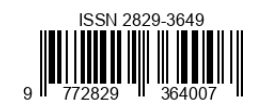THE URGENCY OF CHILD EDUCATION MODELS PERSPECTIVE OF TARBAWI HADITS
DOI:
https://doi.org/10.56910/literacy.v1i3.355Keywords:
Educational Model, Children, Tarbawi Hadith, UrgencyAbstract
Islam places great emphasis on education for every child. Children's education is very urgent, because in childhood a person experiences various kinds of intelligence development. To raise a child well requires a suitable model that has proven itself. There are many models of children's education in the Hadith of the Prophet Muhammad SAW which can be used as a reference for children's education. The purpose of this paper is to examine the models of children's education contained in the hadith and the urgency of their current application. This type of research uses literature studies, based on literature studies it is known that many modern educational models were actually used by the Prophet Muhammad to educate children, including the value explanation technique model, the direct learning model, the inner work model, the learning while playing model. This can be used as a reference in parenting.
References
'Ulwan, Abdullah Nashih, and Arif Rahman Hakim. Tarbiyatul 'Aulad Fil Islam = Children's Education in Islam. Sukoarjo: Al-Andalus, 2015.
Al-Abrasyi, Muhammad Athiyah. Basic Fundamentals of Islamic Education. Jakarta: Crescent Star, 1970.
AL-LAMRI, S. Ichas Hamid. Development of Values Education in Learning Social Knowledge in Elementary Schools. Jakarta: Ministry of National Education of the Republic of Indonesia, 2006.
Astari, Winda, and Sariah. "The Concept of Parenting in Early Childhood According to Mohammad Fauzil Adhim." Kindergarten: Journal of Islamic Early Childhood Education 5, no. 1 (April 25, 2022): 115. Accessed November 13, 2022. https://ejournal.uin-suska.ac.id/index.php/KINDERGARTEN/article/view/16835.
At-Tamimi, Muhammad. Book of Tawhid. Jakarta: Darul Haq, 1999.
Bahar, Asmaniar. "Assessment of the Affective Domain of Internship Learning Through Model Value Clarification Technique (VCT) Games" (2008). Accessed November 13, 2022. https://lib.ui.ac.id.
Darmadi. It's Fun to Learn While Playing. Bogor: Guepedia Publisher, 2018.
Eliasa, Eva Imania. "The Importance of Parental Attachment in the Internal Working Model for the Formation of Children's Character (Study Based on the Attachment Theory of John Bowlby)." in Character as the Essence of Early Childhood Development. Yogyakarta: Inti Media Yogyakarta in Collaboration with the Center for Early Childhood Education Research Institute, Yogyakarta State University (2011).
Fitriningsih. "The Urgency of Aqidah-Based Early Childhood Education." Journal of Musawa IAIN Palu 8, no. 1 (2016): 55–68.
Hairin, Yulia. "Prophetic Parenting as a Parenting Model in the Formation of Children's Character (Akhlak)." Journal of Studia Insania 4, no. 1 (April 30, 2016): 79–94. Accessed November 13, 2022. http://jurnal.uin-antasari.ac.id/index.php/insania/article/view/1115.
Hidayat, Tatang, Ahmad Syamsu Rizal, and Fahrudin. "Education in an Islamic Perspective and Its Role in Fostering Islamic Personality." Mudarrisuna Journal: Media for the Study of Islamic Religious Education 8, no. 2 (December 30, 2018): 218–244. Accessed November 13, 2022. https://jurnal.ar-raniry.ac.id/index.php/mudarrisuna/article/view/3397.
Ibn-Qayyim-al-Jauziyyah. Only for you, my son: A complete guide to children's education from the womb to adulthood. Jakarta: Imam Asy-syafi'i Library, 2010.
Ministry of Education and Culture. Models of Early Childhood Education One Year Before Elementary School: A Study of Non-Formal and Informal Early Childhood Education, and Community Education. Jakarta: Center for Education and Culture Policy Research, Balitbang, Ministry of Education and Culture, 2017.
Khusni, Moh Faishol. "Phases of Child Development and Patterns of Development in an Islamic Perspective." Dignity: Journal of Women and Children 2, no. 2 (December 20, 2018).
Nurhadi. "Family Education Perspective of the Prophet Muhammad's Hadith." INSANIA: Journal of Educational Alternative Thinking 24, no. 1 (June 2, 2019): 1–34. Accessed November 13, 2022. https://ejournal.uinsaizu.ac.id/index.php/insania/article/view/2696.
———. “Interfaith Theological Education in Reaching a Happy Family (Analysis of Islamic, Christian, Hindu, Buddhist and Confucian Theory).” AL-USWAH: Journal of Research and Studies in Islamic Religious Education 1, no. 2 (January 20, 2019): 67–87. Accessed November 13, 2022. https://ejournal.uin-suska.ac.id/index.php/AL-USWAH/article/view/5224.
———. "Demographic Trilogy for Elementary School Children's Education (SD)." Islamika 2, no. 2 (July 31, 2020): 176–191. Accessed November 13, 2022. https://ejournal.stitpn.ac.id/index.php/islamika/article/view/650.
Nurhadi, and Rizizco Ardianto Murti. "Children's Human Rights in the Perspective of Islamic Law." Mimbar Yustitia 2, no. 1 (June 27, 2018): 19–39. Accessed November 13, 2022. http://e-jurnal.unisda.ac.id/index.php/mimbar/article/view/1249.
Padjrin. "Parenting Styles in the Perspective of Islamic Education." Journal of Intellectuality: Islam, Social and Science 5, no. 1 (September 6, 2016): 1–14. Accessed November 13, 2022. http://jurnal.radenfatah.ac.id/index.php/intellectualita/article/view/720.
Ministry of National Education Language Center. Indonesia Dictionary. Jakarta: Balai Pustaka, 2007.
Rasyim, Armin Ibnu, and Halimatus Syadi'yah. "Prenatal Child Education According to Islamic Teachings." Ad-Diniyah Axiom 1, no. 1 (2013). Accessed November 13, 2022. https://ejurnal.latansamashiro.ac.id/index.php/JAD/article/view/151.
Rifa'i, Andi Arif. "Children's Education in Islam: Efforts to Prepare Future Generations with Noble Morals." Edugama: Religious Education and Social Journal 4, no. 2 (December 31, 2018): 73–88. Accessed November 13, 2022. https://jurnal.lp2msasbabel.ac.id/index.php/edu/article/view/744.
Ruhani, Sujiono and Yuliani. Early Childhood Education Concept. Jakarta: Index, 2009.
Sanjaya, Vienna. Educational Process Standards Oriented Learning Strategies. Jakarta: Prenadamedia, 2016.
Siswanto, Hadi. "Problems of Basic Education and Early Childhood Education." Scholar: Journal of Education and Learning 8, no. 2 (October 3, 2014): 137–150. Accessed November 13, 2022. https://cendekia.soloclcs.org/index.php/cendekia/article/vi







